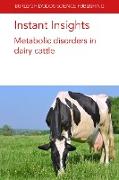This specially curated collection features four reviews of current and key research on metabolic disorders in dairy cattle.
The first chapter reviews the prevalence, etiology and effects of ruminal acidosis, as well as ways to counteract it through regulation of ruminal pH. The chapter includes a case study on subacute rumen acidosis (SARA) in the post-partum phase of the transition period.
The second chapter assesses the main pathways for rumen fermentation which is a major factor in efficient transformation of nutrients. It discusses factors influencing the efficiency of microbial growth as well as the interactions between rumen energy and nitrogen metabolism in ensuring efficient digestion and avoiding metabolic disorders.
The third chapter investigates the genetics of improving feed intake efficiency which has significant potential in reducing metabolic disorders. The chapter reviews key challenges in developing genomic selection indices for feed intake, including recording feed intake, pooling genetic data and establishing genomic breeding values for feed efficiency.
The fourth chapter discusses how cereal grains impact feed efficiency in cattle. It reviews how cereal grains can be used to improve feed efficiency and the microbiology of cereal grain fermentation. The chapter also discusses ways of avoiding acidosis and other negative feed effects.


